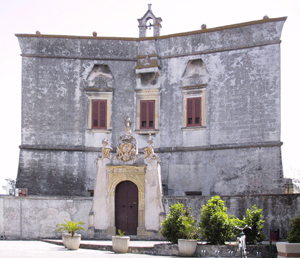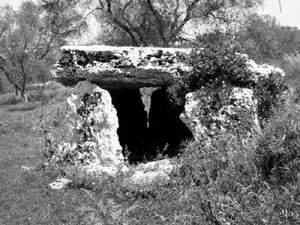|
|

| Inhabitants' name: Melendugnesi |
The civic coat of arms of Melendugno is a
beehive situated on the trunk of a pine. Indeed, Melendugno was
 called
the honey village, and it was the main producer in the province of Lecce. The
apiculture was interrupted by the middle of the XX century, when the bees and
the beehives were completely destroyed during the disinfestations. As far as the
origins of Melendugno are concerned some historians maintain that the centre was
founded during the XI century after the arrival of the Normans, nonetheless the
presence of two dolmens, the "Placa" and the "Gargulante" testify the presence
of people during the Prehistoric Age. The Cave of the Poetry and the Messapian
walls near Rocavecchia ( Melendugno) were built during the Messapian Age. The
feudal circumstances of Melendugno are documented and similar to those of the
neighbouring villages. The first vassal was Berardo Paladini who died in 1448;
he was succeeded by his son (until 1472 )who died very young. The dynasty of the
Paladini barons finished with the ninth baron: Giorgio Antonio Paladini. After
the Paladinis Melendugno called
the honey village, and it was the main producer in the province of Lecce. The
apiculture was interrupted by the middle of the XX century, when the bees and
the beehives were completely destroyed during the disinfestations. As far as the
origins of Melendugno are concerned some historians maintain that the centre was
founded during the XI century after the arrival of the Normans, nonetheless the
presence of two dolmens, the "Placa" and the "Gargulante" testify the presence
of people during the Prehistoric Age. The Cave of the Poetry and the Messapian
walls near Rocavecchia ( Melendugno) were built during the Messapian Age. The
feudal circumstances of Melendugno are documented and similar to those of the
neighbouring villages. The first vassal was Berardo Paladini who died in 1448;
he was succeeded by his son (until 1472 )who died very young. The dynasty of the
Paladini barons finished with the ninth baron: Giorgio Antonio Paladini. After
the Paladinis Melendugno was governed by the D'Afflittos who gave the feud to the family D'Amelj in 1732
because of the several debts. The D'Amelj reigned at Melendugno until 1806 when
the feudal system was suppressed. Among the most illustrious native characters
there are Pietro Paolo Elia (a very well known physician), Edoardo Macchia (a
satirical draftsman and painter, he drew the first caricature of the Duce ),
Antonio Macchia (a good lawyer), Clemente Boccardo and Brizio Elia.
was governed by the D'Afflittos who gave the feud to the family D'Amelj in 1732
because of the several debts. The D'Amelj reigned at Melendugno until 1806 when
the feudal system was suppressed. Among the most illustrious native characters
there are Pietro Paolo Elia (a very well known physician), Edoardo Macchia (a
satirical draftsman and painter, he drew the first caricature of the Duce ),
Antonio Macchia (a good lawyer), Clemente Boccardo and Brizio Elia.
|